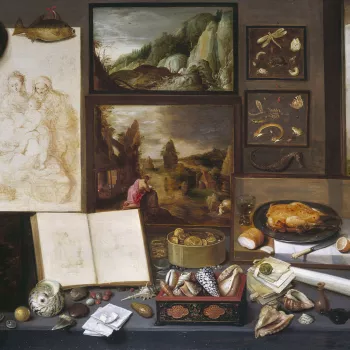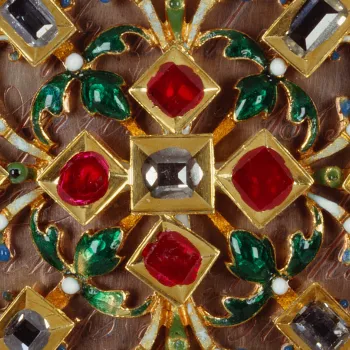Cup and cover c.1700 with later additions
Ivory, silver gilt, emeralds, rubies, turquoises | 49.8 x 16.6 x 20.2 cm (whole object) | RCIN 50554
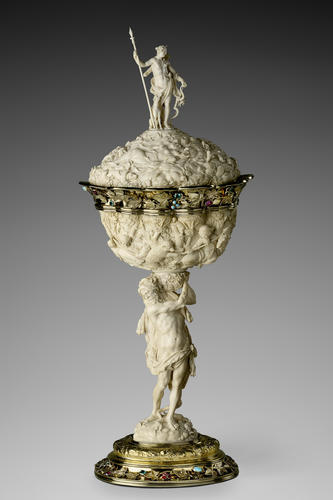
Attributed to? Johann Gottfried Frisch (active 1689-1716)
Cup and cover c.1700 with later additions
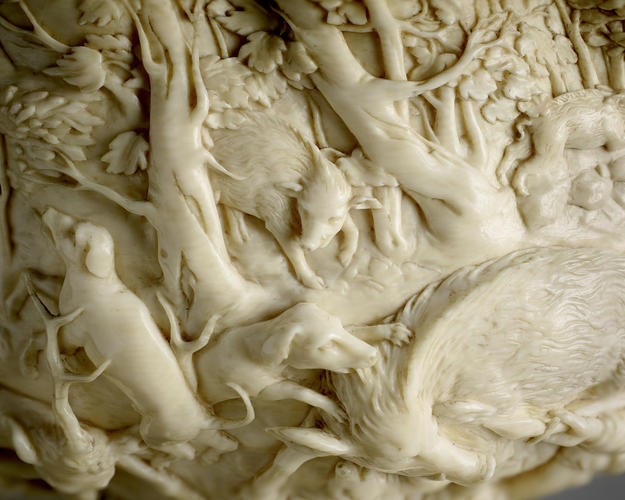
Attributed to? Johann Gottfried Frisch (active 1689-1716)
Cup and cover c.1700 with later additions
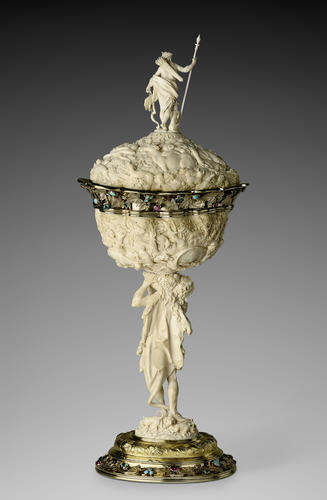
Attributed to? Johann Gottfried Frisch (active 1689-1716)
Cup and cover c.1700 with later additions
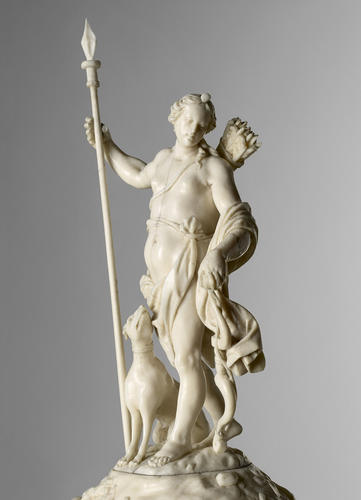
Attributed to? Johann Gottfried Frisch (active 1689-1716)
Cup and cover c.1700 with later additions
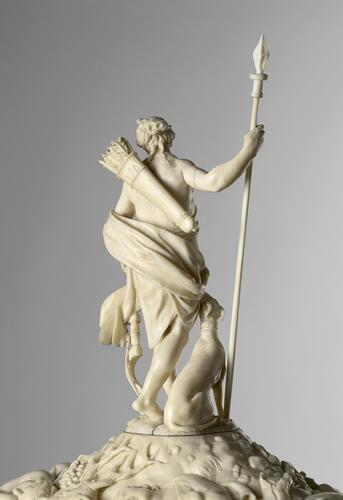
Attributed to? Johann Gottfried Frisch (active 1689-1716)
Cup and cover c.1700 with later additions

Attributed to? Johann Gottfried Frisch (active 1689-1716)
Cup and cover c.1700 with later additions

Attributed to? Johann Gottfried Frisch (active 1689-1716)
Cup and cover c.1700 with later additions
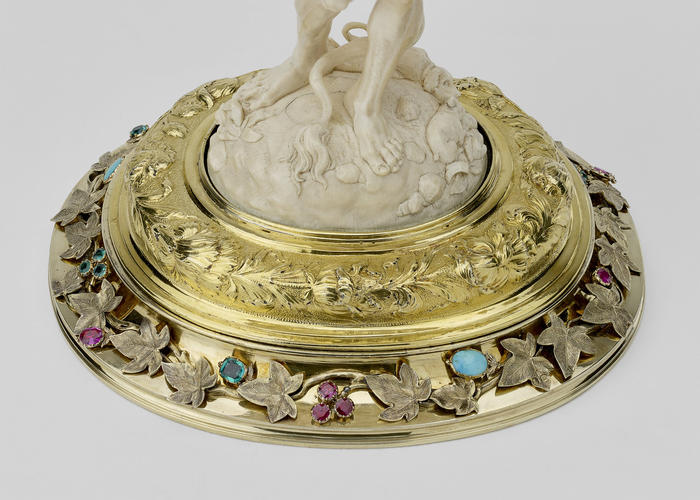
Attributed to? Johann Gottfried Frisch (active 1689-1716)
Cup and cover c.1700 with later additions

Attributed to? Johann Gottfried Frisch (active 1689-1716)
Cup and cover c.1700 with later additions









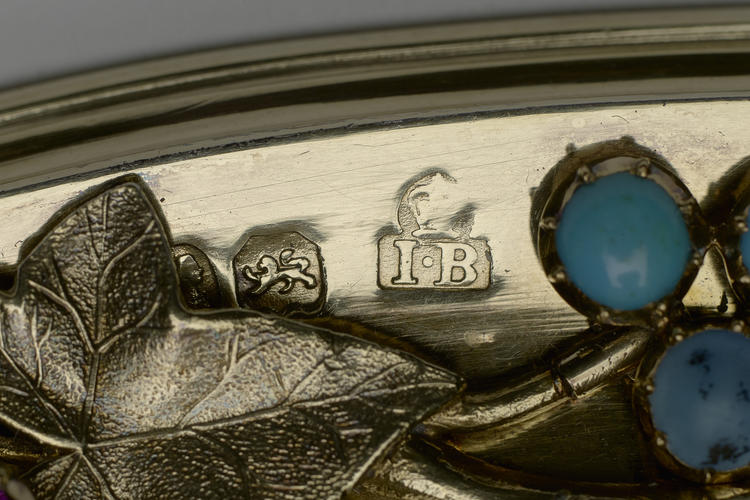
-
A carved lobed ivory cup and cover with silver-gilt and jewelled mounts. The domed cover has a finial carved as Diana holding a spear, with a hunting hound beside her; she is surrounded by sleeping hunters and animals (hares, hounds and boars) with a reeded silver-gilt rim. The ovoid bowl has a silver-gilt rim with applied ivy leaves, mounted with gemstones (rubies, emeralds and turquoises), and is carved in high relief with further hunting scenes. It is supported on a stem carved as Hercules on a domed rocky base, with a silver-gilt border and similar rim of jewelled ivy leaves.
The arrival in England of this superb example of virtuoso ivory carving was announced in the 'Morning Post and Daily Advertiser' on 20 May 1788: 'RECENTLY brought from Vienna, and added to the Museum, an inconceivably beautiful effort of art.... consisting of a cup or vessel carved in ivory; the figure of Hercules dressed in the skin of the Nemean lion forms the handle or stem'. A few weeks later one Professor Thorkelin of Copenhagen attributed it to the Danish court sculptor Magnus Berg. A tentative attribution has since been made to the southern German ivory carver Johann Gottfried Frisch.
The cup was first in the Holophusicon, Sir Ashton Lever's noted collection of natural history and ethnography, opened in Leicester House in 1775. The collection was acquired (via a winning lottery ticket) by James Parkinson in 1786. Parkinson bought this cup and cover from Vienna two years later. The Holophusicon was dispersed by auction in 1806 (in perhaps 8,000 lots). This piece was subsequently acquired by the collector William Beckford of Fonthill Abbey. There it was illustrated in John Rutter's Delineations of Fonthill and its Abbey of 1823, prominently displayed in King Edward's Gallery on the Borghese Table, flanked by two ivory vases (now in the British Museum). Most of Beckford's collection was sold by auction in 1823 when George IV purchased the cup for 90 guineas. The King shared Beckford's taste for virtuoso pieces in exotic materials and the cup joined a growing collection of mounted ivories in Carlton House. The original chased silver-gilt mounts were evidently too plain for George IV's increasingly flamboyant tastes and in 1824 Rundells added 'a new silver chased rim... set with coloured stones to raise the cover' for £148 10s.
On original foot, illegible city mark and maker's mark of D.G.; on later foot, mark of London, date letter for 1824/5, duty mark and maker's mark of John Bridge.Provenance
Brought from Vienna by James Parkinson, 1788; sold King & Lochee, London, 1806; acquired by R. Davies, York Street, London; by whom sold to William Beckford, 1813; by whom sold to John Farquhar; by whom sold, Phillips, Fonthill Abbey, Wiltshire, 27 September 1823 (lot 573); acquired George IV (90 gns).
This was sent to Rundell, Bridge and Rundell in 1824 for additions, including the jewelled mounts, for £148 10s (RA/GEO/MAIN/26327). -
Creator(s)
(goldsmith)Acquirer(s)
-
Medium and techniques
Ivory, silver gilt, emeralds, rubies, turquoises
Measurements
49.8 x 16.6 x 20.2 cm (whole object)
2503.7 g (Weight) (whole object)
Bibliographic reference(s)
EAJ : Jones, E.A., 1911. The Gold and Silver of Windsor Castle, Letchworth p.54




